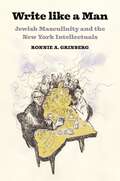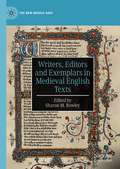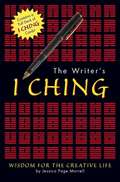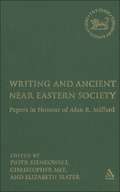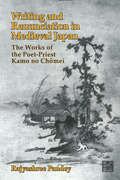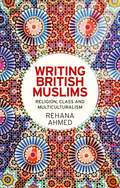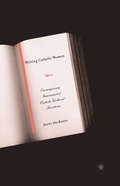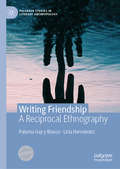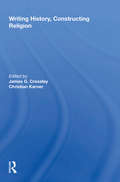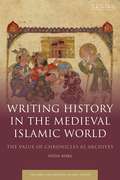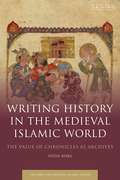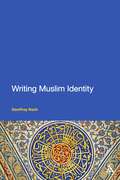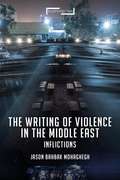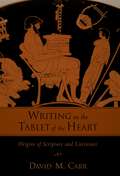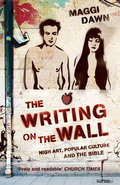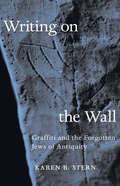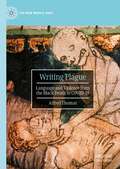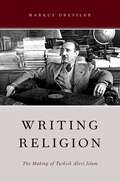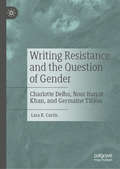- Table View
- List View
Write like a Man: Jewish Masculinity and the New York Intellectuals
by Ronnie GrinbergHow virility and Jewishness became hallmarks of postwar New York&’s combative intellectual sceneIn the years following World War II, the New York intellectuals became some of the most renowned critics and writers in the country. Although mostly male and Jewish, this prominent group also included women and non-Jews. Yet all of its members embraced a secular Jewish machismo that became a defining characteristic of the contemporary experience. Write like a Man examines how the New York intellectuals shared a uniquely American conception of Jewish masculinity that prized verbal confrontation, polemical aggression, and an unflinching style of argumentation.Ronnie Grinberg paints illuminating portraits of figures such as Norman Mailer, Hannah Arendt, Lionel and Diana Trilling, Mary McCarthy, Norman Podhoretz, Midge Decter, and Irving Howe. She describes how their construction of Jewish masculinity helped to propel the American Jew from outsider to insider even as they clashed over its meaning in a deeply anxious project of self-definition. Along the way, Grinberg sheds light on their fraught encounters with the most contentious issues and ideas of the day, from student radicalism and the civil rights movement to feminism, Freudianism, and neoconservatism.A spellbinding chronicle of mid-century America, Write like a Man shows how a combative and intellectually grounded vision of Jewish manhood contributed to the masculinization of intellectual life and shaped some of the most important political and cultural debates of the postwar era.
Writers, Editors and Exemplars in Medieval English Texts (The New Middle Ages)
by Sharon M. RowleyThis collection of essays explores the literary legacy of medieval England by examining the writers, editors and exemplars of medieval English texts. In order to better understand the human agency, creativity and forms of sanctity of medieval England, these essays investigate both the production of medieval texts and the people whose hands and minds created, altered and/or published them. The chapters consider the writings of major authors such as Chaucer, Gower and Wyclif in relation to texts, authors and ideals less well-known today, and in light of the translation and interpretive reproduction of the Bible in Middle English. The essays make some texts available for the first time in print, and examine the roles of historical scholars in the construction of medieval English literature and textual cultures. By doing so, this collection investigates what it means to recover, study and represent some of the key medieval English texts that continue to influence us today.
The Writer's I Ching: Wisdom for the Creative Life
by Elaura Niles Jessica MorrellThe writing life is solitary and challenging, and it takes far more than creativity to become a commercial success. The Writer's I Ching uses the ancient Chinese divination system to provide writers with help mastering the business of writing and choosing the most propitious times to take action. Because writing educators created the book, it also teaches the storyteller and non-fiction craft with lessons suitable for both beginners and seasoned professionals.This unique presentation of the I Ching features a complete deck of 64 cards bound into the book itself. The writer poses a question about how to proceed on a specific fiction or non-fiction project, negotiation, or business matter. He draws an I Ching card and turns to the proper page for the interpretation of that card. Many cases of writer's block have been cured and flashes of insight gained through this simple technique. The I Ching dates back to before Christ and counts among its devotees Confucius, Albert Einstein, and Bob Dylan.
Writing and Ancient Near East Society: Essays in Honor of Alan Millard (The Library of Hebrew Bible/Old Testament Studies)
by Piotr Bienkowski E. A. Slater C. B. MeeThis book honors the significant and enduringwork of Old Testament scholar Alan Millard. The contributors to thisfestschrift take up all of his concerns with the relationship betweenwriting, the development and Israel, and ancient Near Eastern society.
Writing and Renunciation in Medieval Japan: The Works of the Poet-Priest Kamo no Chomei (Michigan Monograph Series in Japanese Studies #21)
by Rajyashree PandeyThis is the first monograph-length study in English of Kamo no Chomei, one of the most important literary figures of medieval Japan. Drawing upon a wide range of writings in a variety of genres from the Heian and Kamakura periods, Pandey focuses on the terms kyogen kigo (wild words and fancy phrases), shoji soku nehan (samsara is nirvana), hoben (expedient means), and suki (single-minded devotion to an art). She shows how these terms deployed by writers in an attempt to reconcile literary and artistic activities with a commitment to Buddhism. By locating Chomei within this broad context, the book offers an original reading of his texts, while at the same time casting a light upon intellectual preoccupations that were central to the times. Writing and Renunciation in Medieval Japan is an important contribution to a growing body of work that challenges the rigid distinction between the religious and literary—a distinction that would have made little sense to medieval writers, many of whom were poets as well as priests—and sheds light on the particular ways in which a religio-aesthetic tradition came to be articulated in medieval Japan. Through an examination of records left by Chomei's contemporaries, the book also traces the life of Chomei, particularly his activities as a court poet and the circumstances that led to his taking the tonsure.
Writing British Muslims: Religion, class and multiculturalism
by Rehana AhmedThe Rushdie affair, September 11 2001 and 7/7 pushed British Muslims into the forefront of increasingly fraught debate about multiculturalism. Stereotyping images have proliferated, reducing a heterogeneous minority group to a series of media soundbites.This book examines contemporary literary representations of Muslims by British writers of South Asian Muslim descent – including Salman Rushdie, Hanif Kureishi, Monica Ali and Nadeem Aslam – to explore the contribution they make to urgent questions about multicultural politics and the place of Muslims within Britain. By focusing on class, and its intersection with faith, ‘race’ and gender in identity- and community-formation, it challenges the dichotomy of secular freedom versus religious oppression that constrains thinking about British Muslims, and offers a more nuanced perspective on multicultural debates and controversies.Writing British Muslims will appeal to academics and postgraduate and final-year undergraduate students in the fields of postcolonial studies, English studies and cultural studies.
Writing Catholic Women: Contemporary International Catholic Girlhood Narratives
by J. DelRossoWriting Catholic Women examines the interplay of gender, race, ethnicity, nationality, and sexuality through the lens of Catholicism in a wide range of works by women writers, forging interdisciplinary connections among women's studies, religion, and late twentieth-century literature. Discussing a diverse group of authors, Jeana DelRosso posits that the girlhood narratives of such writers constitute highly charged sites of their differing gestures toward Catholicism and argues that an understanding of the ways in which women write about religion from different cultural and racial contexts offers a crucial contribution to current discussions in gender, ethnic, and cultural studies.
Writing Friendship: A Reciprocal Ethnography (Palgrave Studies in Literary Anthropology)
by Paloma Gay y Blasco Liria HernándezThis book tells the remarkable story of the friendship between Liria Hernández, a Roma woman from Madrid, and Paloma Gay y Blasco, a non-Roma anthropologist. In this unique reciprocal experiment, the former informant returns the gaze to write about the anthropologist, her life and her environment. Through finely crafted and deeply moving text, Hernández and Gay y Blasco suggest new ways of doing and writing anthropology. The dialogue between Hernández and Gay y Blasco provides a courageous account of the entanglements and rewards of anthropological research. Drawing on letters, conversations, and fieldnotes gathered over twenty-five years, each of the authors talks about herself, the other, and the impact of anthropology on their two lives. They examine their intertwined trajectories as Spanish women and reflect on the challenges of devising their own reciprocal genre. Blending ethnography, life story and memoir, they undermine the dichotomy between author and subject around which scholarship still revolves.
Writing History, Constructing Religion
by James G. Crossley Christian KarnerWriting History, Constructing Religion presents a much-needed interdisciplinary exploration of the significance of debates among historians, scholars of religion and cultural theorists over the 'nature' of history to the study of religion. The distinguished authors discuss issues related to definitions of history, postmodernism, critical theory, and the impact on the study and analysis of religious traditions; exploring the application of writing 'history from below', discussions of 'truth' and 'objectivity' as opposed to power and ideology, crises of representation, and the place of theory in the 'historicized' study of religion(s). Addressing conceptual debates in a wide range of historical and empirical contexts, the authors critically engage with issues including religious nationalism, Nazism, Islam and the West, secularism, religion in post-Communist Russia, ethnicity and post modernity. This book constitutes a significant step towards the self-reflexive and interdisciplinary study of religions in history.
Writing History, Constructing Religion
by James G. Crossley Christian KarnerWriting History, Constructing Religion presents a much-needed interdisciplinary exploration of the significance of debates among historians, scholars of religion and cultural theorists over the 'nature' of history to the study of religion. The distinguished authors discuss issues related to definitions of history, postmodernism, critical theory, and the impact on the study and analysis of religious traditions; exploring the application of writing 'history from below', discussions of 'truth' and 'objectivity' as opposed to power and ideology, crises of representation, and the place of theory in the 'historicized' study of religion(s). Addressing conceptual debates in a wide range of historical and empirical contexts, the authors critically engage with issues including religious nationalism, Nazism, Islam and the West, secularism, religion in post-Communist Russia, ethnicity and post modernity. This book constitutes a significant step towards the self-reflexive and interdisciplinary study of religions in history.
Writing History in the Medieval Islamic World: The Value of Chronicles as Archives (Early and Medieval Islamic World)
by Fozia BoraIn the 'encyclopaedic' fourteenth century, Arabic chronicles produced in Mamluk cities bore textual witness to both recent and bygone history, including that of the Fatimids (969–1171CE). For in two centuries of rule over Egypt and North Africa, the Isma'ili Fatimids had left few self-generated historiographical records. Instead, it fell to Ayyubid and Mamluk historians to represent the dynasty to posterity. This monograph sets out to explain how later historians preserved, interpreted and re-organised earlier textual sources.Mamluk historians engaged in a sophisticated archival practice within historiography, rather than uncritically reproducing earlier reports. In a new diplomatic edition, translation and analysis of Mamluk historian Ibn al-Furat's account of late Fatimid rule in The History of Dynasties and Kings, a widely known but barely copied universal chronicle of Islamic history, Fozia Bora traces the survival of historiographical narratives from Fatimid Egypt. Through Ibn al-Furat's text, Bora demonstrates archivality as the heuristic key to Mamluk historical writing.This book is essential for all scholars working on the written culture and history of the medieval Islamic world, and paves the way for a more nuanced reading of pre-modern Arabic chronicles and of the epistemic environment in which they were produced.
Writing History in the Medieval Islamic World: The Value of Chronicles as Archives (Early and Medieval Islamic World)
by Fozia BoraIn the 'encyclopaedic' fourteenth century, Arabic chronicles produced in Mamluk cities bore textual witness to both recent and bygone history, including that of the Fatimids (969–1171CE). For in two centuries of rule over Egypt and North Africa, the Isma'ili Fatimids had left few self-generated historiographical records. Instead, it fell to Ayyubid and Mamluk historians to represent the dynasty to posterity. This monograph sets out to explain how later historians preserved, interpreted and re-organised earlier textual sources.Mamluk historians engaged in a sophisticated archival practice within historiography, rather than uncritically reproducing earlier reports. In a new diplomatic edition, translation and analysis of Mamluk historian Ibn al-Furat's account of late Fatimid rule in The History of Dynasties and Kings, a widely known but barely copied universal chronicle of Islamic history, Fozia Bora traces the survival of historiographical narratives from Fatimid Egypt. Through Ibn al-Furat's text, Bora demonstrates archivality as the heuristic key to Mamluk historical writing.This book is essential for all scholars working on the written culture and history of the medieval Islamic world, and paves the way for a more nuanced reading of pre-modern Arabic chronicles and of the epistemic environment in which they were produced.
Writing Muslim Identity: The Construction Of Identity
by Geoffrey NashThe relationship between Islam andthe West is one of the most urgent and hotly debated issues of our time. Thisbook is the first to offer a comprehensive overview of the way in which Muslimsare represented within modern English writing, ranging from the novel, throughmemoir and travel writing to journalism. Covering a wide range of texts andauthors, it scrutinises the identity 'Muslim' by looking at its inscription inrecent and contemporary literary writing within the context of significantevents like the Rushdie Affair and 9/11. Examining the wide range of writinginternationally that takes Islam or Islamic cultures as its focus, the authordiscusses the representation of Muslim identity in writing by non-Muslimwriters, former Muslim 'native informants', and practising Muslims.
Writing Muslim Identity: The Construction Of Identity
by Geoffrey NashThe relationship between Islam andthe West is one of the most urgent and hotly debated issues of our time. Thisbook is the first to offer a comprehensive overview of the way in which Muslimsare represented within modern English writing, ranging from the novel, throughmemoir and travel writing to journalism. Covering a wide range of texts andauthors, it scrutinises the identity 'Muslim' by looking at its inscription inrecent and contemporary literary writing within the context of significantevents like the Rushdie Affair and 9/11. Examining the wide range of writinginternationally that takes Islam or Islamic cultures as its focus, the authordiscusses the representation of Muslim identity in writing by non-Muslimwriters, former Muslim 'native informants', and practising Muslims.
The Writing of Violence in the Middle East: Inflictions (Suspensions: Contemporary Middle Eastern and Islamicate Thought)
by Jason Bahbak MohagheghWriting has come face-to-face with a most crucial juncture: to negotiate with the inescapable presence of violence. From the domains of contemporary Middle Eastern literature, this book stages a powerful conversation on questions of cruelty, evil, rage, vengeance, madness, and deception. Beyond the narrow judgment of violence as a purely tragic reality, these writers (in states of exile, prison, martyrdom, and war) come to wager with the more elusive, inspiring, and even ecstatic dimensions that rest at the heart of a visceral universe of imagination. Covering complex and controversial thematic discussions, Jason Bahbak Mohaghegh forms an extreme record of voices, movements, and thought-experiments drawn from the inner circles of the Middle Eastern region. By exploring the most abrasive writings of this vast cultural front, the book reveals how such captivating outsider texts could potentially redefine our understanding of violence and its now-unstoppable relationship to a dangerous age.
The Writing of Violence in the Middle East: Inflictions (Suspensions: Contemporary Middle Eastern and Islamicate Thought)
by Jason Bahbak MohagheghWriting has come face-to-face with a most crucial juncture: to negotiate with the inescapable presence of violence. From the domains of contemporary Middle Eastern literature, this book stages a powerful conversation on questions of cruelty, evil, rage, vengeance, madness, and deception. Beyond the narrow judgment of violence as a purely tragic reality, these writers (in states of exile, prison, martyrdom, and war) come to wager with the more elusive, inspiring, and even ecstatic dimensions that rest at the heart of a visceral universe of imagination. Covering complex and controversial thematic discussions, Jason Bahbak Mohaghegh forms an extreme record of voices, movements, and thought-experiments drawn from the inner circles of the Middle Eastern region. By exploring the most abrasive writings of this vast cultural front, the book reveals how such captivating outsider texts could potentially redefine our understanding of violence and its now-unstoppable relationship to a dangerous age.
Writing on the Tablet of the Heart: Origins of Scripture and Literature
by David M. CarrThis book explores a new model for the production, revision, and reception of Biblical texts as Scripture. Building on recent studies of the oral/written interface in medieval, Greco-Roman and ancinet Near Eastern contexts, David Carr argues that in ancient Israel Biblical texts and other texts emerged as a support for an educational process in which written and oral dimensions were integrally intertwined. The point was not incising and reading texts on parchment or papyrus. The point was to enculturate ancient Israelites - particularly Israelite elites - by training them to memorize and recite a wide range of traditional literature that was seen as the cultural bedorck of the people: narrative, prophecy, prayer, and wisdom.
Writing on the Tablet of the Heart Origins of Scripture and Literature: Origins of Scripture and Literature
by David M. CarrThis book explores a new model for the production, revision, and reception of Biblical texts as Scripture. Building on recent studies of the oral/written interface in medieval, Greco-Roman and ancinet Near Eastern contexts, David Carr argues that in ancient Israel Biblical texts and other texts emerged as a support for an educational process in which written and oral dimensions were integrally intertwined. The point was not incising and reading texts on parchment or papyrus. The point was to enculturate ancient Israelites - particularly Israelite elites - by training them to memorize and recite a wide range of traditional literature that was seen as the cultural bedorck of the people: narrative, prophecy, prayer, and wisdom.
The Writing on the Wall: High Art, Popular Culture and the Bible
by Maggi DawnIn an increasingly secularised society, the average person is unlikely to have a working knowledge of the Bible. Yet a great deal of our culture is built on stories or ideas that come from the Bible. Literature, art, music, language and even the fabric of our society - such as our justice system - is built on Christian concepts and biblical references. THE WRITING ON THE WALL provides a fascinating introduction to the Bible's best-known, and most influential, stories.
Writing on the Wall: Graffiti and the Forgotten Jews of Antiquity
by Karen SternFew direct clues exist to the everyday lives and beliefs of ordinary Jews in antiquity. Prevailing perspectives on ancient Jewish life have been shaped largely by the voices of intellectual and social elites, preserved in the writings of Philo and Josephus and the rabbinic texts of the Mishnah and Talmud. Commissioned art, architecture, and formal inscriptions displayed on tombs and synagogues equally reflect the sensibilities of their influential patrons. The perspectives and sentiments of nonelite Jews, by contrast, have mostly disappeared from the historical record. Focusing on these forgotten Jews of antiquity, Writing on the Wall takes an unprecedented look at the vernacular inscriptions and drawings they left behind and sheds new light on the richness of their quotidian lives.Just like their neighbors throughout the eastern and southern Mediterranean, Mesopotamia, Arabia, and Egypt, ancient Jews scribbled and drew graffiti everyplace--in and around markets, hippodromes, theaters, pagan temples, open cliffs, sanctuaries, and even inside burial caves and synagogues. Karen Stern reveals what these markings tell us about the men and women who made them, people whose lives, beliefs, and behaviors eluded commemoration in grand literary and architectural works. Making compelling analogies with modern graffiti practices, she documents the overlooked connections between Jews and their neighbors, showing how popular Jewish practices of prayer, mortuary commemoration, commerce, and civic engagement regularly crossed ethnic and religious boundaries.Illustrated throughout with examples of ancient graffiti, Writing on the Wall provides a tantalizingly intimate glimpse into the cultural worlds of forgotten populations living at the crossroads of Judaism, Christianity, paganism, and earliest Islam.
Writing on the Wall: Graffiti and the Forgotten Jews of Antiquity
by Karen SternFew direct clues exist to the everyday lives and beliefs of ordinary Jews in antiquity. Prevailing perspectives on ancient Jewish life have been shaped largely by the voices of intellectual and social elites, preserved in the writings of Philo and Josephus and the rabbinic texts of the Mishnah and Talmud. Commissioned art, architecture, and formal inscriptions displayed on tombs and synagogues equally reflect the sensibilities of their influential patrons. The perspectives and sentiments of nonelite Jews, by contrast, have mostly disappeared from the historical record. Focusing on these forgotten Jews of antiquity, Writing on the Wall takes an unprecedented look at the vernacular inscriptions and drawings they left behind and sheds new light on the richness of their quotidian lives.Just like their neighbors throughout the eastern and southern Mediterranean, Mesopotamia, Arabia, and Egypt, ancient Jews scribbled and drew graffiti everyplace--in and around markets, hippodromes, theaters, pagan temples, open cliffs, sanctuaries, and even inside burial caves and synagogues. Karen Stern reveals what these markings tell us about the men and women who made them, people whose lives, beliefs, and behaviors eluded commemoration in grand literary and architectural works. Making compelling analogies with modern graffiti practices, she documents the overlooked connections between Jews and their neighbors, showing how popular Jewish practices of prayer, mortuary commemoration, commerce, and civic engagement regularly crossed ethnic and religious boundaries.Illustrated throughout with examples of ancient graffiti, Writing on the Wall provides a tantalizingly intimate glimpse into the cultural worlds of forgotten populations living at the crossroads of Judaism, Christianity, paganism, and earliest Islam.
Writing Plague: Language and Violence from the Black Death to COVID-19 (The New Middle Ages)
by Alfred ThomasWriting Plague: Language and Violence from the Black Death to COVID-19 brings a holistic and comparative perspective to “plague writing” from the later Middle Ages to the twenty-first century. It argues that while the human “hardware” has changed enormously between the medieval past and the present (urbanization, technology, mass warfare, and advances in medical science), the human “software” (emotional and psychological reactions to the shock of pandemic) has remained remarkably similar across time. Through close readings of works by medieval writers like Guillaume de Machaut, Giovanni Boccaccio, and Geoffrey Chaucer in the fourteenth century, select plays by Shakespeare, and modern “plague” fiction and film, Alfred Thomas convincingly demonstrates psychological continuities between the Black Death and COVID-19. In showing how in times of plague human beings repress their fears and fantasies and displace them onto the threatening “other,” Thomas highlights the danger of scapegoating vulnerable minority groups such as Asian Americans and Jews in today’s America. This wide-ranging study will thus be of interest not only to medievalists but also to students of modernity as well as the general reader.
Writing Religion: The Making of Turkish Alevi Islam (AAR Reflection and Theory in the Study of Religion)
by Markus DresslerIn the late 1980s, the Alevis, at that time thought to be largely assimilated into the secular Turkish mainstream, began to assert their difference as they never had before. The question of Alevism's origins and its relation to Islam and to Turkish culture became a highly contested issue. According to the dominant understanding, Alevism is part of the Islamic tradition, although located on its margins. It is further assumed that Alevism is intrinsically related to Anatolian and Turkish culture, carrying an ancient Turkish heritage, leading back into pre-Islamic Central Asian Turkish pasts. Dressler argues that this knowledge about the Alevis-their demarcation as "heterodox" but Muslim and their status as carriers of Turkish culture-is in fact of rather recent origins. It was formulated within the complex historical dynamics of the late Ottoman Empire and the first years of the Turkish Republic in the context of Turkish nation-building and its goal of ethno-religious homogeneity.
Writing Resistance and the Question of Gender: Charlotte Delbo, Noor Inayat Khan, and Germaine Tillion
by Lara R. CurtisThis book presents the first comparative study of the works of Charlotte Delbo, Noor Inayat Khan, and Germaine Tillion in relation to their vigorous struggles against Nazi aggression during World War II and the Holocaust. It illuminates ways in which their early lives conditioned both their political engagements during wartime and their extraordinary literary creations empowered by what Lara R. Curtis refers to as modes of ‘writing resistance.’ With skillful recourse to a remarkable variety of genres, they offer compelling autobiographical reflections, vivid chronicles of wartime atrocities, eyewitness accounts of victims, and acute perspectives on the political implications of major events. Their sensitive reflections of gendered subjectivity authenticate the myriad voices and visions they capture. In sum, this book highlights the lives and works of three courageous women who were ceaselessly committed to a noble cause during the Holocaust and World War II.
